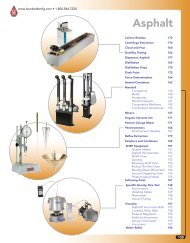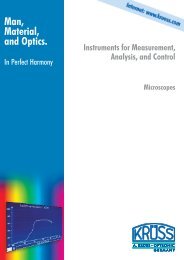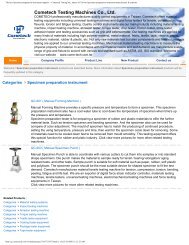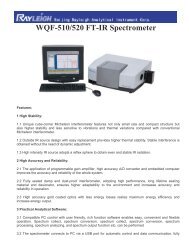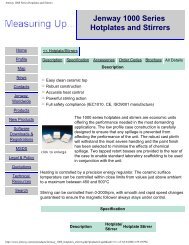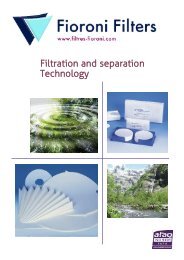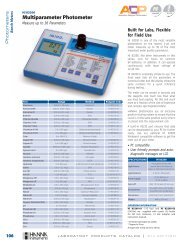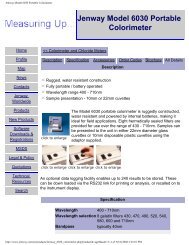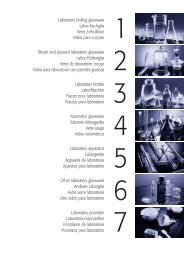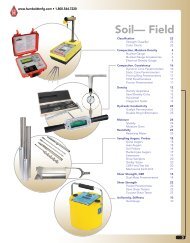Esco Labculture® Plus Class II Type A2 Biosafety Cabinet - Comlibris
Esco Labculture® Plus Class II Type A2 Biosafety Cabinet - Comlibris
Esco Labculture® Plus Class II Type A2 Biosafety Cabinet - Comlibris
Create successful ePaper yourself
Turn your PDF publications into a flip-book with our unique Google optimized e-Paper software.
ULPA-filtered air<br />
Unfiltered / potentially contaminated air<br />
Room air / Inflow air<br />
• Automatic start-up sequence will prepare<br />
the cabinet for normal operation<br />
and advise when safe conditions are<br />
established.<br />
• An administrator controlled PIN (Per-<br />
sonal Identification Number) can be set<br />
to restrict access to main menu.<br />
• The airflow alarm can be activated or<br />
deactivated depending on user preference<br />
and nature of the work.<br />
Consult your <strong>Esco</strong> Operating Manual or<br />
contact <strong>Esco</strong> or your Sales Representative<br />
for information on user-preference programming<br />
capabilities built into the Sentinel<br />
microprocessor platform.<br />
Redundant Blower System<br />
The Infinity blower system is designed for<br />
high performance operation, redundancy,<br />
maximum energy efficiency and minimal<br />
maintenance.<br />
<strong>Cabinet</strong> Filtration System<br />
Side capture zones<br />
Dynamic air barrier, inflow and<br />
forward-directed downflow air converge<br />
Ambient air is pulled through the perforations<br />
located towards the work zone front<br />
to prevent contamination of the work surface<br />
and work product. The inflow does<br />
not mix with the clean air within the cabinet<br />
work zone. Inflow air travels through<br />
a return path toward the common air<br />
plenum (blower plenum) at the top of the<br />
cabinet.<br />
Approximately 35% of the air in the<br />
common plenum is exhausted through<br />
the ULPA filter to the room. The remaining<br />
65% of the air is passed through the<br />
downflow ULPA filter and into the work<br />
area as a vertical laminar flow air stream<br />
bathing the work surface in clean air.<br />
The uniform, non-turbulent air stream<br />
protects against cross contamination<br />
within and throughout the work area.<br />
• Dual permanently lubricated direct-drive<br />
external rotor motor/blowers safety in<br />
the event of a motor failure.<br />
• The external rotor motor design allows<br />
for optimum cooling of the motor<br />
during extended operations and extends<br />
the motor bearing life.<br />
• The inflow and downflow balance is<br />
precisely established by two independent<br />
Accuflow fan speed controls.<br />
• The Accuflow microprocessor based<br />
speed controller maintains constant,<br />
stable airflow despite building supply<br />
voltage fluctuations.<br />
• Speed can be adjusted electronically<br />
without mechanical adjustment.<br />
• Built-in RFI and electrical noise filters<br />
eliminate interference with adjacent<br />
instrumentation.<br />
• An integral blower hour meter tracks<br />
<strong>Esco</strong> Centrifugal Fan with External Rotor Motor (left) vs.<br />
Conventional Fan with Standard Motor (right)<br />
<strong>Esco</strong> Infinity cabinets use a combination of high<br />
performance scroll blowers (supply) and German<br />
made ebm-papst ® permanently lubricated, centrifugal<br />
motor/blowers with external rotor designs (exhaust).<br />
Selected for energy efficiency, compact design,<br />
and flat profile, the completely integrated exhaust<br />
blower assembly optimizes motor cooling, with<br />
unified rotating parts and overall component balance<br />
for smooth, quiet, vibration-free operation. Weight<br />
is equally distributed to all bearings to extend bearing<br />
life, transfer heat and maximize speed control.<br />
Biological Safety <strong>Cabinet</strong>s • <strong>Class</strong> <strong>II</strong> Microbiological Safety <strong>Cabinet</strong><br />
Near the work surface, the downflow<br />
air stream splits with a portion moving<br />
toward the front air grille, and the remainder<br />
moving to the rear air grille. A small<br />
portion of the ULPA filtered downflow<br />
enters the intake perforations at the side<br />
capture zones at a higher velocity (small<br />
blue arrows).<br />
A combination of inflow and downflow<br />
air streams forms an air barrier that prevents<br />
contaminated room air from entering<br />
the work zone, and prevents work<br />
surface emissions from escaping the work<br />
zone.<br />
Air returns to the common air plenum<br />
where the 35% exhaust and 65% recirculation<br />
process is continued.<br />
operating life and aids in predictive main-<br />
tenance planning.<br />
• To prevent fan damage, a paper-catch<br />
grille traps papers or towels that may<br />
drop down on the drain pan, preventing<br />
them from being pulled into the column<br />
by fan suction.<br />
<strong>Cabinet</strong> Construction<br />
Robust construction and enhanced safety<br />
features qualify the cabinet for the most<br />
demanding laboratory applications. The<br />
cabinet is fully assembled and ready to<br />
install and operate when shipped.<br />
• The interior sides and back wall are<br />
formed from a single piece of stainlesssteel<br />
with large radius corners to simplify<br />
interior cleaning.<br />
• The cabinet work zone has no welded<br />
joints to collect contaminants or rust.<br />
• All stainless steel work surfaces are<br />
accessible for cleaning.<br />
• Multi-piece tray components are easily<br />
lifted and removed to encourage surface<br />
decontamination.<br />
• A recessed central area and stainless<br />
steel drain pan channels spills and<br />
prevent liquids from entering the lower<br />
filtration and blower systems.



